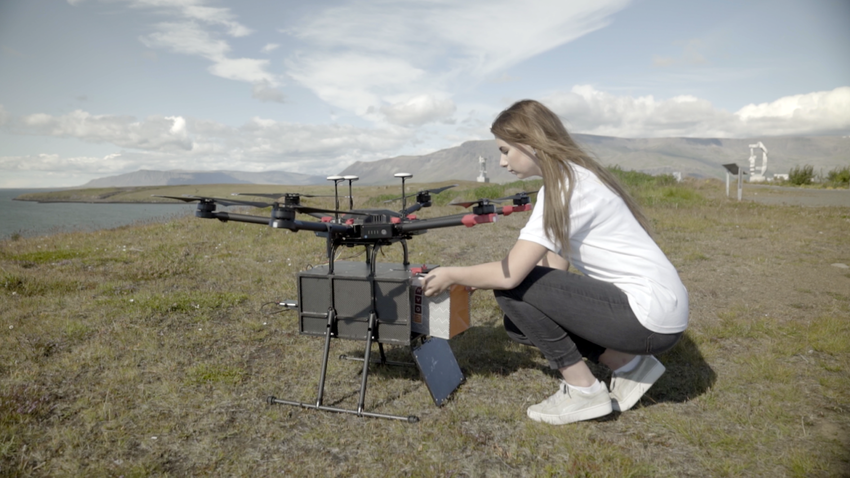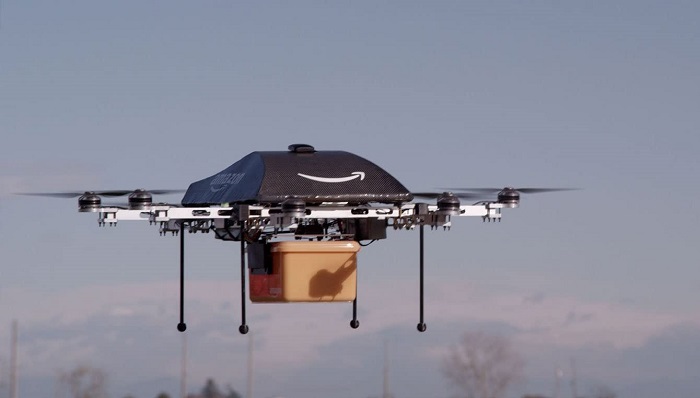ISABEL RUBIO ARROYO | Tungsteno
Back in 2013, Amazon was already dreaming of delivering millions of products with drones zipping through the skies, but it wasn't until late last year that the tech giant finally got approval from the U.S. Federal Aviation Administration (FAA) for its drone delivery service. Given the unstoppable rise of e-commerce, drones promise to revolutionise the parcel delivery sector. But if many companies have been investing in type of technology for years, why hasn’t package delivery by drones taken off yet?
What exactly is Amazon's goal and what other projects are underway?
When you receive a package in the future, you likely won't open the door to a delivery person, but to a machine. Amazon's goal is to send packages of up to two kilograms "safely" to customers in less than 30 minutes. The company claims to be testing "many different vehicle designs and delivery mechanisms to discover how best to deliver packages in a variety of operating environments." Testing is being conducted at development centres in the United States, the United Kingdom, Austria, France and Israel.
In 2019, it unveiled a hybrid between a helicopter and a drone at its global re:MARS event in Las Vegas. "It can do vertical take-offs and landings—like a helicopter. And it’s efficient and aerodynamic—like an airplane. It also easily transitions between these two modes—from vertical mode to airplane mode and back to vertical mode," explains Jeff Wilke, former CEO of Amazon's consumer division. Thanks to artificial intelligence systems, the device uses sensors and algorithms to try to identify and avoid static and moving objects—from chimneys to a paraglider, a helicopter or animals.
Some drones use sensors and algorithms to try to identify and avoid static and moving objects. Crédito: Amazon.
Amazon isn’t the only company experimenting with these devices. Alphabet—Google's parent company—UPS and the U.S. retail giant Walmart are some of the big companies that are introducing delivery drones in their businesses. In Spain, the national postal service Correos has carried out tests with drones capable of reaching 100 kilometres per hour and withstanding winds of up to 40 kilometres per hour.
Why is it so difficult to turn these small projects into mass trials?
In most cases, the answer lies in the regulations, whose main objective is to guarantee safety. In Spain, although experimental flights supervised by the Spanish Aviation Safety Agency (AESA) have been carried out, until a few months ago legislation did not permit the use of unmanned aircraft to deliver packages. This is now allowed, but only if "very demanding" requirements are met, according to Isabel Maestre, director of the State Aviation Safety Agency. Drone flights will be determined by the weight of the drone, the presence of other people and the proximity to buildings.

Given the unstoppable rise of e-commerce, drones promise to revolutionise the parcel delivery sector. Credit: Walmart.
What other obstacles do companies face?
In addition to the legislative barriers, there are the initial implementation costs and the possibility that this type of technology is not mature enough. A drone accident could result in fatalities. Amazon indicates that the appearance and features of its drones will continue to evolve over time. "We know customers will only feel comfortable receiving drone deliveries if they know the system is incredibly safe," Wilke says. Once these kinds of hurdles are overcome, long-term challenges include increasing cargo capacity. Even if legislation allowed it, some heavy shipments could not be handled by many of today's drones.
Why is the idea of using drones to deliver packages so appealing?
The arrival of drones in the skies could bring multiple benefits. The potential of these devices for delivery in emergency situations and isolated areas stands out, as highlighted by Correos: "The intention is to apply this technology to improve the distribution capabilities of Correos and as a complementary tool available to letter carriers to facilitate their delivery tasks in rural areas that are difficult to access or are isolated due to bad weather, without jeopardising their safety."
In addition to accessing hard-to-reach areas, autonomous drones could save companies money and reduce emissions of carbon dioxide and other greenhouse gases. This is particularly important at a time when online commerce is on the rise, boosted by the coronavirus pandemic. Half of Spaniards already shop online, according to the Survey on Equipment and Use of Information and Communication Technologies in Households carried out by the National Statistics Institute.

Autonomous drones could save companies money and reduce emissions of carbon dioxide and other greenhouse gases. Credit: HadasBandel / Wikimedia Commons.
When are drones expected to take to the skies?
Maestre indicates that it is still early for drones to occupy the skies on a massive scale, at least in Spain. "Our vision is that we will start to see initiatives in very limited conditions, such as experimental projects or emergency delivery operations, in the coming months, but the mass transport of consumer goods will have a time horizon of at least two or three years," she explains.
In the meantime, companies like Amazon say they will start using these drones when and where they have the regulatory support to do so safely. The challenges are complex, but the authorization that the e-commerce giant has received to deliver packages with drones in the United States brings us a little closer to that utopian future in which unmanned vehicles zip across the skies to deliver packages in a matter of minutes anywhere in the world.
· — —
Tungsteno is a journalism laboratory to scan the essence of innovation. Devised by Materia Publicaciones Científicas for Sacyr’s blog.
